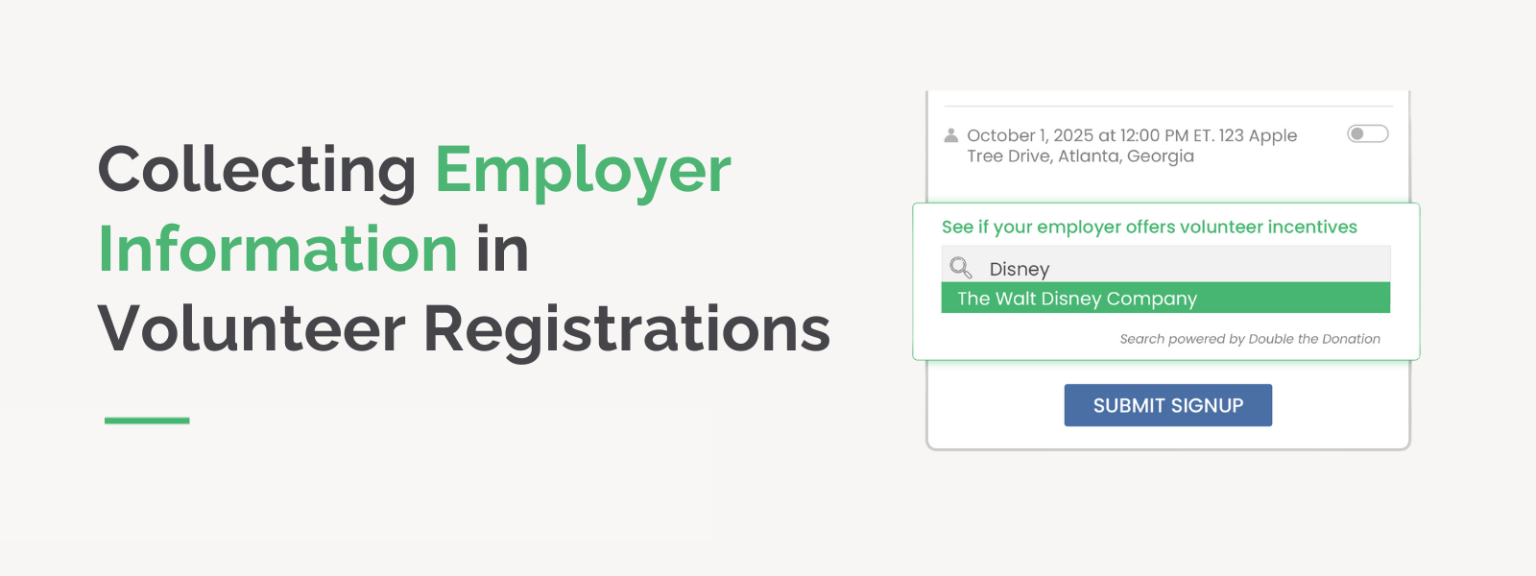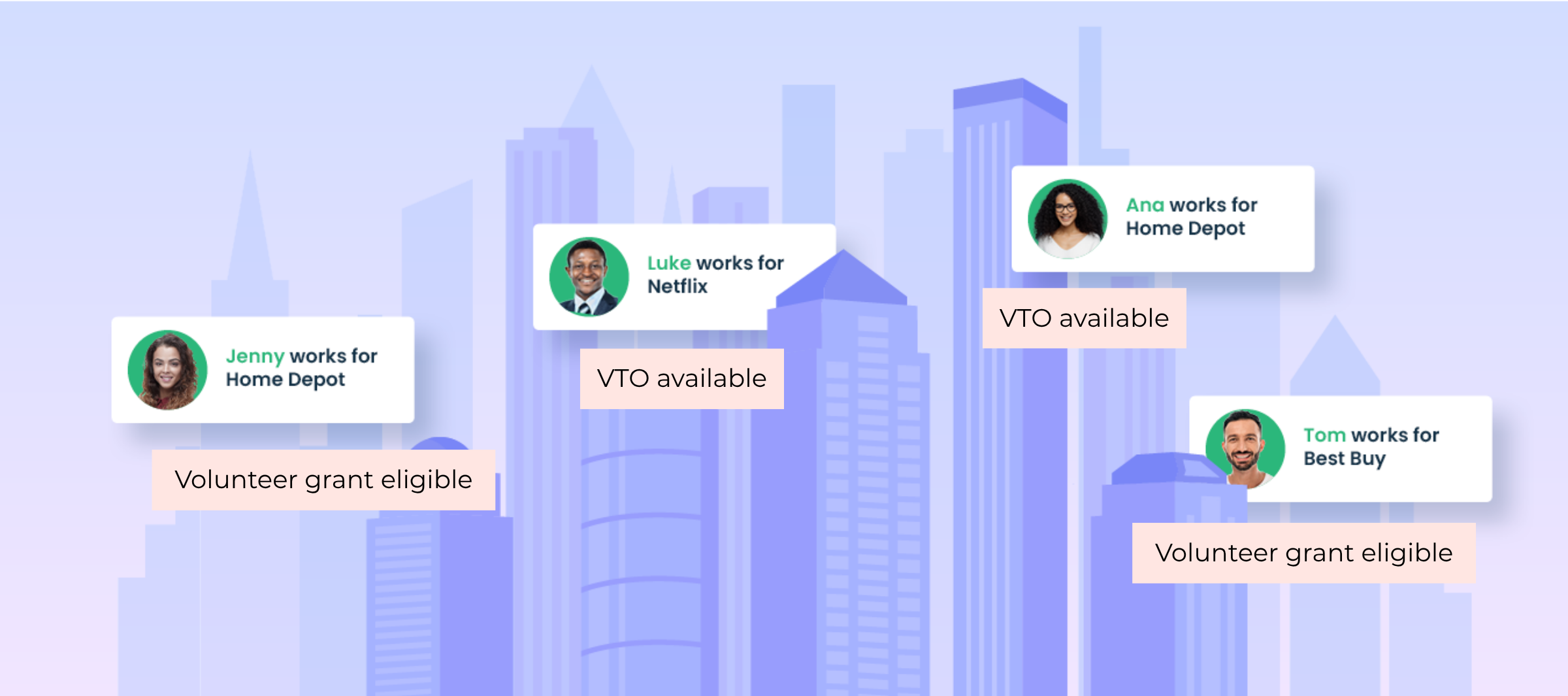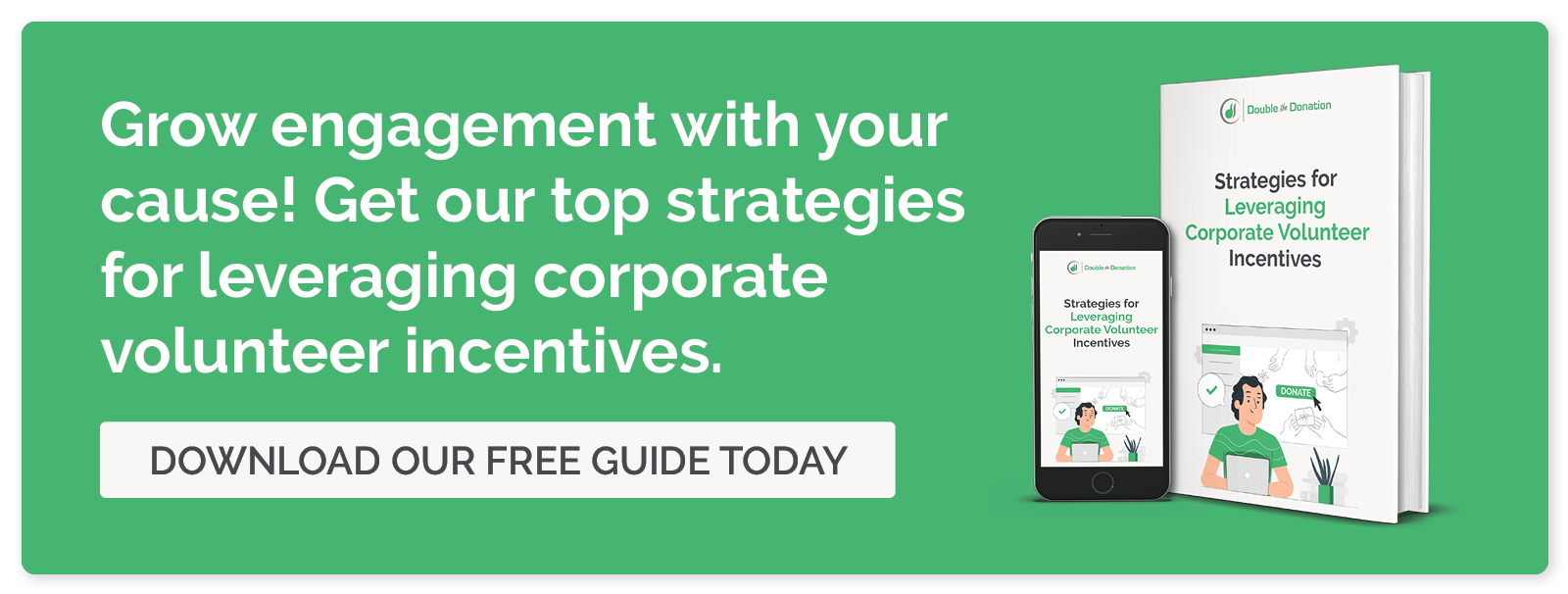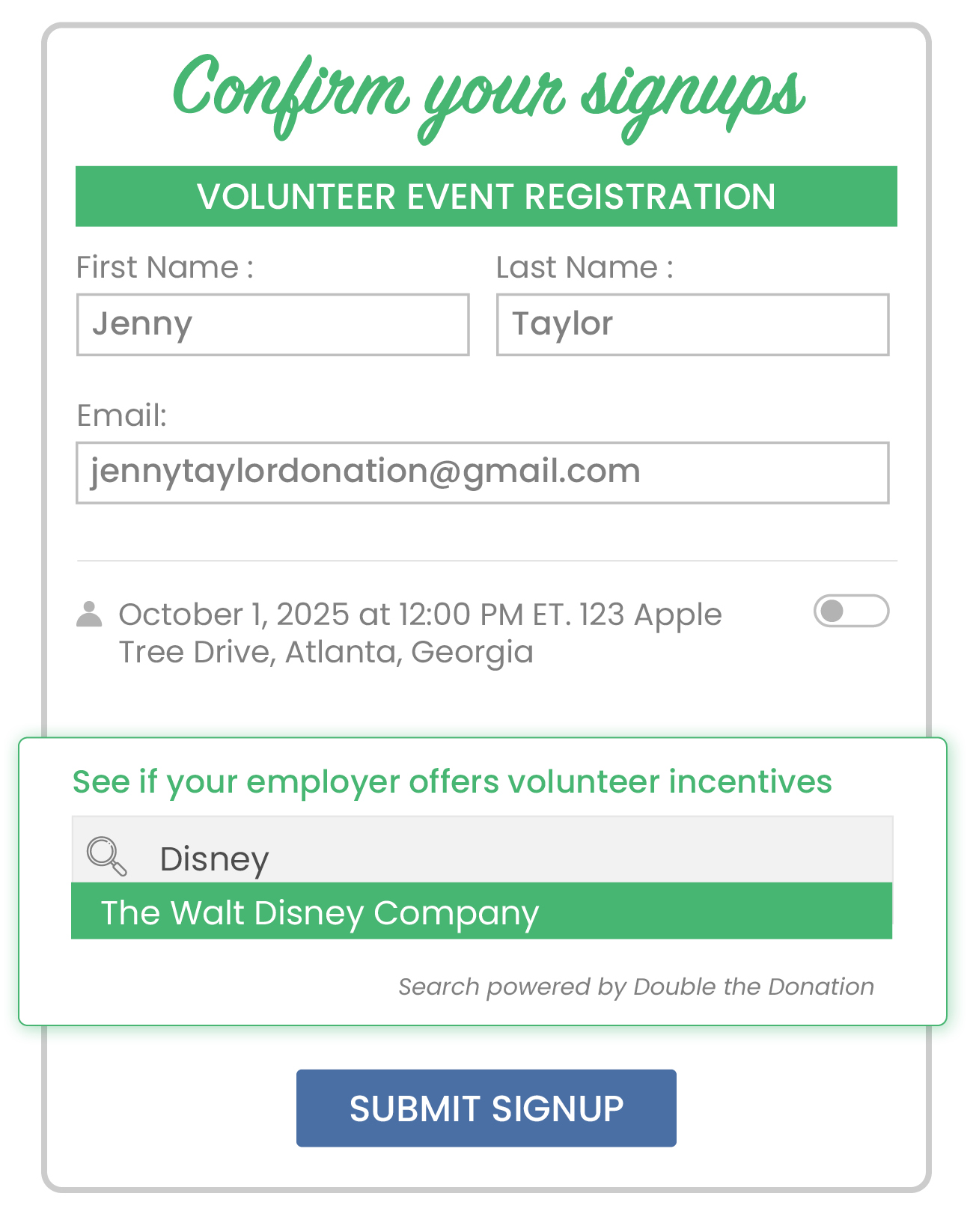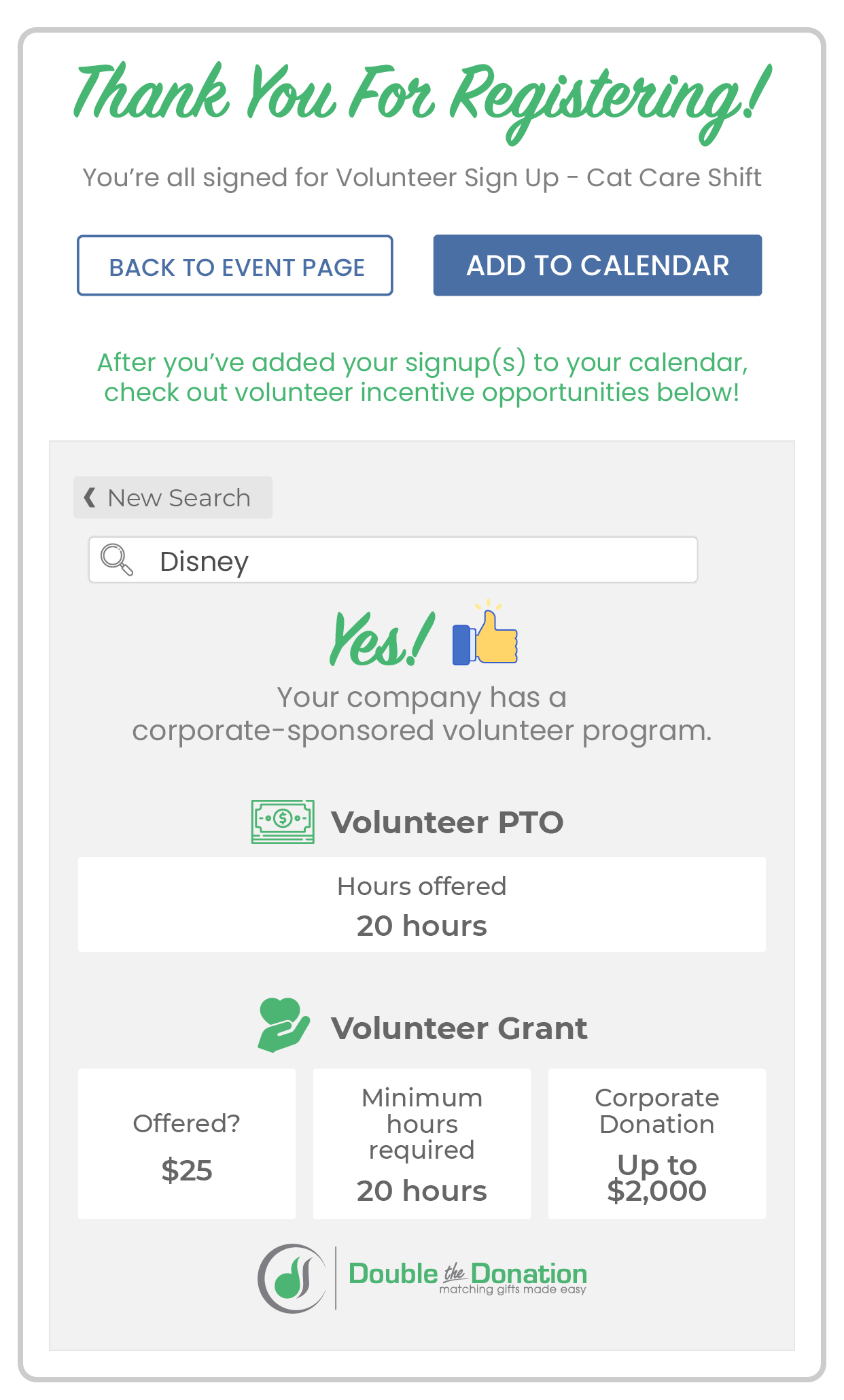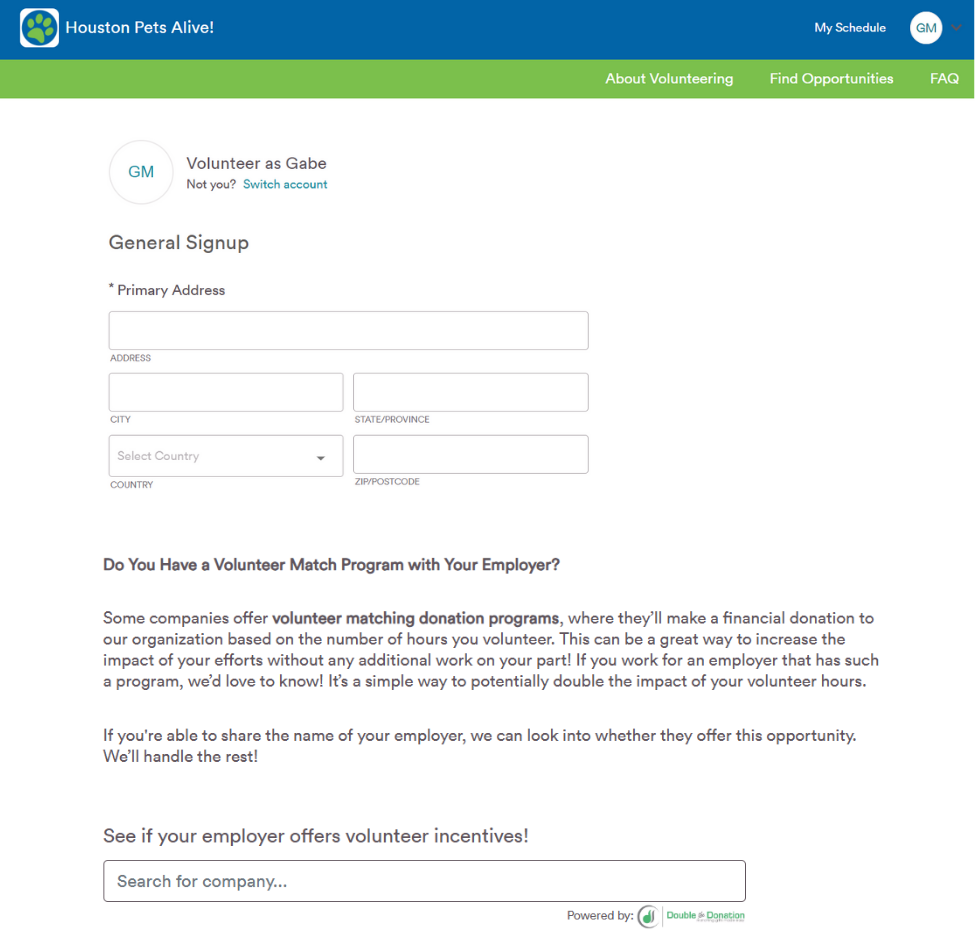Collecting Employer Information in Volunteer Registrations
Collecting employer information in volunteer registrations is a crucial strategy for nonprofits seeking to maximize their outreach, fundraising, and engagement potential. By understanding where their volunteers work, organizations can identify opportunities for corporate volunteer incentives and more.
In this post, we’ll explore the benefits of gathering employer details in volunteer registrations. Additionally, we’ll provide practical tips for nonprofits to effectively integrate this step into their volunteer sign-up process. We’re going to cover:
- The Importance of Employer Information for Nonprofits & Schools
- Benefits of Collecting Employer Information in Volunteer Registrations
- How to Collect Employer Information During the Registration Process
- Leveraging Employer Information for Volunteer Programs
- Common Challenges and Solutions for Collecting Employer Information
- See it in Action: How One Organization Collects Employer Info in Volunteer Forms
Equipping your team with accurate and up-to-date employer data not only strengthens relationships with individual volunteers but also opens doors to additional resources that can significantly enhance the impact of a nonprofit’s programming. The rewards are endless—and the best place to access this information is directly within your volunteer registrations.
Let’s begin!
The Importance of Employer Information for Nonprofits & Schools
Collecting employer information from volunteers, donors, and other supporters is a strategic practice that can significantly benefit both nonprofits and schools. After all, understanding where constituents work provides invaluable insights that can open doors to a range of opportunities.
Here’s why employer information is crucial:
- Uncovering workplace giving programs. Thousands of companies offer workplace giving programs that support the organizations their employees donate to or volunteer with. Knowing where your donors and volunteers work can help your team identify opportunities for matching gifts, volunteer incentives, payroll deductions, and more.
- Establishing more well-rounded supporter profiles. The more you know about your supporters, the better you can engage them with your organization. Use employer data to customize your outreach and add a personal touch to your communications once your supporter profiles are filled in!
- Identifying potential partnerships. Companies want to support the organizations their employees are involved with. If a number of your donors or volunteers come from a single company, try reaching out to them to pitch a one-off giving program or volunteer opportunity.
In summary, employer information is a valuable asset that fundraising organizations can leverage to further their missions. Collecting and utilizing this data helps organizations unlock the full potential of corporate support, ultimately advancing their missions more effectively than ever before.
Benefits of Collecting Employer Information in Volunteer Registrations
With any number of opportunities to collect employer information from your supporters, what makes your volunteer registration forms an ideal location?
Let’s take a look at the benefits of this particular method:
Volunteers are likely highly engaged with your cause while actively registering for an event. When volunteers sign up for an event, they are actively demonstrating their interest and commitment to your cause. This moment of heightened engagement makes it an ideal time to gather additional information, such as employer details.
Volunteers are already expected to provide personal information in the registration process. During the volunteer registration process, participants are typically asked to provide basic personal details, including their name, contact information, and emergency contact information. Because they are already sharing personal information, including an additional field for employer details is a natural extension of the form, rather than an extra burden.
Volunteers appreciate the opportunity to amplify their impact through workplace giving. Many volunteers are motivated by the opportunity to make a greater impact, and workplace giving programs, such as volunteer grants, provide a straightforward way to do so. When volunteers know that their employer offers opportunities to double or triple the impact of their support, they are often eager to participate.
Volunteers are often required to complete the request process ahead of engaging in their activities. When an individual wishes to use their corporate volunteer incentives (e.g., VTO), they typically need to request the time off from their employer beforehand. Promoting the opportunity from the start, i.e., in registrations, ensures that each volunteer has the time they need to obtain proper approval before the event arrives.
How to Collect Employer Information During the Registration Process
Now that you understand why you should incorporate employer information into your volunteer registration forms, we’ll take a look at some actionable strategies that your team can adopt in order to do so.
Here’s a step-by-step overview of the process you’ll want to follow:
- Design an optimized volunteer registration form. Begin by creating a registration form that is both user-friendly and visually appealing, featuring a clear layout and minimal clutter. Make the form concise to encourage completion while ensuring it collects the necessary information.
- Implement an optional field or employer search tool. Add an optional field for “Employer Name” to encourage volunteers to provide this information. For optimal results, consider implementing an employer search tool with auto-suggest functionality. This way, as volunteers type, the tool can suggest company names, reducing the chances of typos or incomplete entries.
- Mention why you’re collecting the information. Provide a brief explanation about why you’re collecting this data. Explain how employer details help identify volunteer incentives that could amplify the impact of their contributions.
- Direct volunteer traffic to your registration forms. Begin promoting your volunteer registration forms to ensure they reach your audience. Make the registration process easy to find and complete by providing direct links and clear calls to action, encouraging potential volunteers to sign up and provide their information.
- Send employer data to your Double the Donation platform. If you use a platform like Double the Donation, integrate it with your registration form to automatically transfer employer information to your donor database. This streamlines the process, allowing you to identify volunteer grants, VTO, and other opportunities as efficiently as possible.
Following these steps ensures that employer information is collected efficiently during the volunteer registration process. And doing this enables your organization to leverage corporate giving programs, build partnerships, and maximize the impact of volunteer contributions.
Learn more about Double the Donation’s Volunteer functionality with this quick video:
Leveraging Employer Information for Volunteer Programs
Once you’ve collected employer data (whether in your volunteer registrations or otherwise), it’s time to put it to good use. One of the most valuable purposes of this information is locating available corporate volunteer programs. Now that you have employment information on hand, you can use it to identify those who work for companies with powerful volunteer programs, send them highly targeted emails related to the programs, and connect individuals with their specific next steps in the process. And, of course, the end result of doing so is additional funding for your cause.
While these programs vary from one company to the next, it’s a good idea to become familiar with the types of programs you might see. Generally, these will include:
- Volunteer grants — Corporate programs where companies provide monetary donations to nonprofits based on their employees’ volunteer hours. This incentivizes employees to engage in volunteer work and helps nonprofits receive additional funding.
- Volunteer time off (or VTO) — Programs that allow employees to take paid time off from work to volunteer for charitable organizations. This encourages employees to give back to their communities without sacrificing their personal time or pay.
- Skills-based volunteerism — Opportunities that involve employees using their professional skills and expertise to support nonprofit organizations. This type of volunteerism provides access to high-quality professional services, such as marketing, legal, or IT, that may otherwise not be within the organization’s budget.
- Corporate volunteer days — Organized events where a company’s employees participate in volunteer activities as a group. These events may be held during work hours and are often planned around specific causes or projects, such as environmental cleanups or community service projects.
Each of these programs encourages employee involvement in the community and helps companies support charitable causes in meaningful ways. When you know where your volunteers (or donors!) work, you can identify individuals who may qualify for workplace volunteer programs like these.
Not to mention, when you utilize Double the Donation’s volunteer incentive database tool, you can even provide company-specific information on available volunteer programs directly from your registration confirmation page!
Common Challenges and Solutions for Collecting Employer Information
If you don’t currently have a strategy for collecting employer information in volunteer registrations, don’t fret. Many organizations face challenges when gathering this information, but we have the solutions ready for you.
Challenge: Not collecting the information at all.
Organizations often overlook the value of employer information and may miss the opportunity to collect it during volunteer registrations. This can limit their ability to identify corporate philanthropy opportunities, such as matching gifts or volunteer grants, and hinder their efforts to maximize volunteer contributions.
Solution: Start asking for employer information in volunteer registration forms.
To overcome this challenge, organizations should add an employer information field to their volunteer registration forms. Even if it’s optional, including this field increases the chances of gathering valuable data that can help unlock corporate giving opportunities.
Challenge: Collecting the information too late.
When employer information is requested after volunteers have already signed up or participated in an event, it can be challenging to gather accurate data. This delay may reduce response rates or lead to missed opportunities for volunteer grants or volunteer time off associated with recent activities. Not to mention, VTO requests typically need to be submitted prior to the event occurring.
Solution: Request employer information from your initial volunteer sign-ups.
To avoid this issue, organizations should request employer information at the very beginning of the volunteer registration process. This ensures that relevant details are collected upfront, allowing the organization to identify corporate giving opportunities and engage volunteers in workplace giving programs from the outset. Plus, early collection sets the stage for more effective follow-up and donor engagement.
Challenge: Leveraging outdated information.
Just because you’ve accessed an individual’s employer information at one point in time doesn’t mean it will be the same for the foreseeable future. Unfortunately, relying on outdated employer information can be problematic, as supporters may change jobs or employers over time. This can result in inaccurate data and missed opportunities if the organization continues to base its outreach on outdated records.
Solution: Regularly refresh supporters’ profiles with up-to-date details.
To keep employer information current, organizations should periodically prompt volunteers and donors to update their profiles. The best way to do so is to ask them for the information each time they register for an event or complete a donation.
Regularly refreshing supporter data ensures that organizations have accurate information for pursuing both volunteer incentives and broader corporate partnerships.
Challenge: Employer information going unused.
Even when employer data is collected, it may not be effectively leveraged by the organization. This lack of data utilization often results in missed opportunities to engage volunteers and corporate partnerships going unrealized.
Solution: Utilize the information for workplace giving incentives.
Train your staff on the importance of leveraging employer information for fundraising and corporate engagement. Teams can use this data to identify volunteer incentives, target companies with multiple supporters, or reach out about establishing new programs.
See it in Action: How One Organization Collects Employer Info in Volunteer Forms
Maybe you’re considering the addition of an employer information field or search tool to your volunteer registration forms. But first, you want to see what other organizations are doing. You’re in luck! Check out this example of a leading fundraising organization collecting employment information directly as individuals register for volunteer activities.
Houston Pets Alive!
Houston Pets Alive! is dedicated to reducing the number of animals euthanized in the Houston area by providing medical care, rehabilitation, and adoption services for at-risk pets. Their mission revolves around rescuing and rehoming animals in need while promoting responsible pet ownership within the community.
This organization takes a proactive approach by embedding a volunteer program search tool directly into its registration form. Volunteers are prompted with a clear callout: “Do You Have a Volunteer Match Program with Your Employer?” and given the option to search for their company by name. This strategy is effective because:
- It educates volunteers in real time about the existence of volunteer grant programs.
- The embedded search tool (powered by Double the Donation Volunteering) makes it simple to confirm eligibility.
- It reframes employer information not as “extra data” but as an opportunity to double the impact of volunteer hours.
By integrating this option upfront, Houston Pets Alive! reduces friction for volunteers while simultaneously surfacing new, often overlooked revenue streams. This tactic works well because it feels natural to include employer information alongside personal details while creating an early opportunity to check for eligibility in volunteer grant and other workplace giving programs. Even if volunteers skip the field, the organization now has a structured way to collect employment data that can be leveraged later.
Next Steps for More Impactful Volunteer Registrations
Including employer information in volunteer registrations presents a valuable opportunity for nonprofits to expand their networks and enhance their fundraising potential. By connecting with volunteers’ workplaces, organizations can unlock opportunities such as volunteer grants, time off for volunteering, and even corporate partnerships.
For nonprofits seeking to amplify their impact, investing time in collecting and leveraging this information can make a substantial difference. It’s a simple step that not only enhances the volunteer experience but also fosters stronger ties between nonprofits, volunteers, and their employers.
Interested in securing additional support for your cause? Check out these additional resources to learn more:
- How Donor Employer Information Boosts Fundraising + Workplace Giving. Dive deeper into the power of employer data with this complete guide. Uncover even more ways that this information can benefit your organization.
- 20 Top Volunteer Management Tools for Nonprofits & Schools. In order to collect employer information in volunteer registrations, it’s crucial to equip your team with the right VMS. Browse our top recommendations here!
- Standout Strategies for Leveraging Corporate Volunteer Incentives. Get the free guide to learn the ins and outs of corporate volunteer incentives like volunteer grants, VTO, and more.

